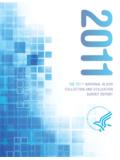Transcription of Guidelines For Setting Up Blood Storage Centres At First ...
1 Maternal Health DivisionDepartment of Family WelfareGovernment of India2003 GuidelinesFor Setting UpBlood Storage CentresAtFirst Referral UnitsGuidelinesfor Setting upBlood Storage CentresatFirst Referral UnitsIForewordIt is estimated that for every 100,000 live births, 407 pregnant women die every year in India due to causes related to pregnancy and childbirth. The major causes of these deaths have been identified as anaemia, hemorrhage (both ante and post partum), toxemia (Hypertension during pregnancy), obstructed labour, puerperal sepsis (infections after delivery) and unsafe abortions. Over the years, efforts to reduce maternal mortality and morbidity have included providing family planning services, improving essential obstetric care including antenatal care, safe/institutional deliveries, prophylaxis and treatment of anaemia and postnatal care and emergency obstetric associated with pregnancies are not always predictable.
2 Therefore, provision of emergency obstetric care as close to the community as possible was envisaged under the CSSM Programme by Setting up First Referral Units at the community health Centres /sub-district level hospitals. However, most of the identified FRUs could not become fully operational due to lack of skilled manpower, particularly anesthetists and gynecologists, adequate infrastructure, medicines and Blood banking facilities. Non-availability of Blood Storage /transfusion facilities at the First referral units has thus been a major constraint in provision of emergency obstetric care services. However, now that the Drug and Cosmetics Rules have been amended, it would be possible to set up Blood Storage Centres at the sub-district level health facilities without going through the elaborate exercise of Setting up Blood Banks in all these places.
3 A core group of experts with Dr (Mrs.) Ira Ray, former Additional Director General of Health Services, Government of India, as the Chairperson and Dr. V. K. Manchanda, Deputy Director General (Maternal Health/Training), as Convener, was constituted to finalise the Guidelines for Setting up of Blood Storage Centres at First referral level units. I am happy to note that the group has not only been able to put together the Guidelines for Setting up the Blood Storage facilities but also drawn up the Standard Operating Protocol and the Clinician s Guidelines for Appropriate use of Blood and Blood products. For the benefit of administrators, clinicians and other health functionaries, the three documents are being put together in one volume.
4 I would like to acknowledge here the efforts put in by the members of the core group. I am sure this effort will go a long way not only in planning and Setting up of the services, but also in ensuring uniform and good quality service at these Blood Storage Centres .(J. V. R. Prasada Rao)Secretary Department of Family WelfareMinistry of Health & Family Welfare Government of India10th June, 2003 IIPrefaceThe National Blood Policy has been adopted. A well organised Blood Transfusion Service (BTS), which is a vital component of the Health care delivery system of the country and expected to ensure accessible and adequate supply of safe and quality Blood and Blood component, is being far, the services have been made available only through established Blood banks extending up to district level.
5 These Blood banks have the responsibility for collection of Blood through proper donor selection, screening these units of Blood , Storage and preventing unnecessary transfusions and establishing an effective quality assurance , the large number of maternal mortality in India is caused by lack of timely availability of safe Blood to women during or after childbirth. The Drugs and Cosmetics Rules so far did not permit the establishment of Blood Storage Centres (BSCs), which has only recently been amended. The BSC must obtain approval from the Drug Controller General of India to initiate their activity and provide for infrastructure and , a provision is being made by the Family Welfare Department of the Government of India, to extend services for providing safe Blood at sub-district levels, First Referral Units (FRUs) through Blood Storage Units.
6 These units would be named Blood Storage Centres (BSCs). These Centres would procure required units of safe Blood from specified Mother Blood Banks, already established at the district hospitals or Regional Blood Transfusion Centres . They would have the responsibility of procuring units of Blood from Mother Blood banks, proper Storage , cross matching, transfusion and all other associated activities. As the BSC will have limited activities, the doctors and technicians already in position could be trained for the job of Blood group of technical experts have prepared a manual for the Setting of Blood Storage Centres at First Referral Units (FRUs). The First part, the Guidelines indicates the requirements and responsibilities of BSCs, which may be used by Policy makers, and Programme Officers.
7 The second part is Standard Operating Procedures detailing the procedures to be followed by the laboratory personnel in conducting the actual tests of cross matching and transfusion. The third part of the document is a guide to rational use of Blood , Blood products and substitutes by is earnestly hoped that this effort of establishing Blood Storage Units at sub-district levels would ensure availability of adequate quantity of safe Blood to a large population and especially to women during (Mrs.) Ira RayNational Consultant, WHO& Former Additional Director GeneralMinistry of Health and Family WelfareAcknowledgementsThe publication of Guidelines for Setting -up the Blood Storage Centres , the Standard Operating Procedures and the Clinician s Guide to appropriate use of Blood and its substitutes, fulfills a long-standing need in the efforts of Department of Family Welfare towards strengthening Emergency Obstetric Care at the First Referral facilities.
8 I gratefully acknowledge the encouragement, guidance and help provided by Shri J. V. R. Prasada Rao, ex-Secretary in Department of Family Welfare. It was due to his initiative that the expert group for working on these Guidelines was constituted and has been able to complete the task within a short period. I am also thankful to Shri S. S. Brar, Joint Secretary (RCH), for his guidance and help during the preparation of these would specifically like to express my gratitude to Dr. Ira Ray, National Consultant-WHO and Chairperson of the expert group, for her contribution and guidance. The time, effort and sharing of thoughts and experiences by the members of the expert group, Dr. R. N. Makroo, Director, Department of Transfusion Medicine, Indraprastha Apollo Hospital, New Delhi, Dr.
9 Veena Doda, Head, Blood Bank, RML Hospital, New Delhi, and Dr. P. Salil, Joint Director, NACO, New Delhi, has been extremely valuable in putting together the Guidelines and I express my sincere appreciation for their owe special thanks to Dr. V. N. Sardana, Consultant, NACO, and my colleagues Dr. Narika Namshum, Dr. Himanshu Bhushan and Dr. D. C. Jain, for their help during the preparation of these acknowledge the help provided by Mrs. Reeta Madan and Shri Shailendra Kumar Singh for their secretarial help in putting together of the document.(Dr. V. K. Manchanda)Deputy Director GeneralMaternal Health & Training DivisionDepartment of Family WelfareMinistry of Health & Family Welfare Government of of Members of the Expert (Mrs.)
10 Ira Ray, National Consultant - WHO ChairpersonB-265, Greater Kailash - INew Delhi - 110 R. N. MakrooMemberDirector, Department of Transfusion MedicineIndraprastha Apollo HospitalNew Delhi - 110 P. Salil, Joint Director (BS)MemberNACO, Chanderlok Building, 36, JanpathNew Delhi - 110 Veena Doda, Head, Blood BankMemberRML Hospital, New Delhi - 110 V. K. Manchanda, DDG (MH/Trg)ConvenerNirman Bhawan, New Delhi - 110 011 Special Invitees V. N. SardanaConsultant (BS)NACOC handerlok Building36, JanpathNew Delhi - 110 Narika NamshumAC (MH-I)Nirman BhawanNew Delhi - 110 Himanshu BhushanAC (MH-II)Nirman BhawanNew Delhi - 110 D. C. JainAC (Trg)Nirman BhawanNew Delhi - 110 011 VIVC ontentsTOPICPAGE ,Documentation, (AnnexureI).






